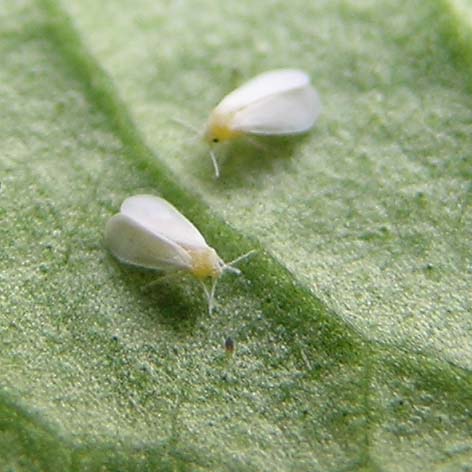ERROR : Server Busy(-1105)
ERROR : Server Busy(-1105)
Greenhouse Whitefly (Trialeurodes vaporariorum) - Wiki
Greenhouse whitefly
From Wikipedia, the free encyclopedia
Scientific classification
Kingdom: Animalia
Phylum: Arthropoda
Class: Insecta
Order: Hemiptera
Suborder: Homoptera
Family: Aleyrodidae
[Photo] Weiße Fliege - Greenhouse Whiteflies (Trialeurodes vaporariorum). Date 13 March 2004. Author: gaucho | Permission is granted to copy, distribute and/or modify this document under the terms of the GNU Free Documentation License, Version 1.2 or any later version published by the Free Software Foundation; with no Invariant Sections, no Front-Cover Texts, and no Back-Cover Texts. A copy of the license is included in the section entitled "GNU Free Documentation License". |
Trialeurodes vaporariorum, commonly known as the glasshouse or greenhouse whitefly inhabits the world’s temperate regions. It is a primary insect pest of many fruit, vegetable and ornamental crops, frequently being found in glasshouses and other protected horticultural environments. Adults are 1-2 mm in length, with yellowish bodies and four wax-coated wings held near parallel to the leaf surface.
Life cycle
Females are capable of mating less than 24 hours after emergence and most frequently lay their eggs on the undersides of leaves. Eggs are pale yellow in colour, before turning grey prior to hatching. Newly hatched larvae, often known as crawlers, are the only mobile immature life-stage. During the first and second larval instars, the appearance is that of a pale yellow/translucent, flat scale which can be difficult to distinguish with the naked eye. During the fourth and final immature life-stage (the pupa), compound eyes and other body tissues become visible as the larvae thicken and rise from the leaf-surface.
Plant damage
All life-stages apart from eggs and pupae cause crop damage through direct feeding, inserting their stylet into leaf veins and extracting nourishment from the phloem sap. As a by-product of feeding, honeydew is excreted and that alone can be a second, major source of damage. The third and potentially most harmful characteristic is the ability of adults to transmit several plant viruses. The crop hosts principally affected are vegetables such as cucurbits, potatoes and tomatoes, although a range of other crop and non-crop plants including weed species are susceptible, and can therefore harbour the infection.
Control
Effective control has been provided for many years through the release of beneficial insects, such as the aphelinid parasitoid, Encarsia formosa (Gahan). If required, integrated pest management strategies can incorporate applications of selective chemical insecticides that complement these natural enemies. For the majority of outdoor crops chemicals are still the most widely used method of control.
http://en.wikipedia.org/wiki/Greenhouse_whitefly
| The text in this page is based on the copyrighted Wikipedia article shown in above URL. It is used under the GNU Free Documentation License. You may redistribute it, verbatim or modified, providing that you comply with the terms of the GFDL. |
|

